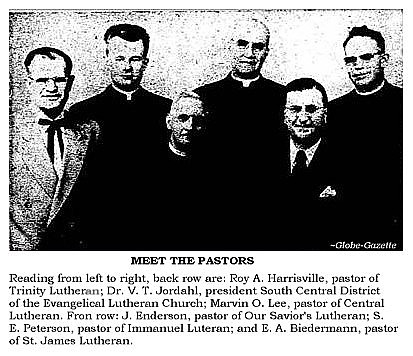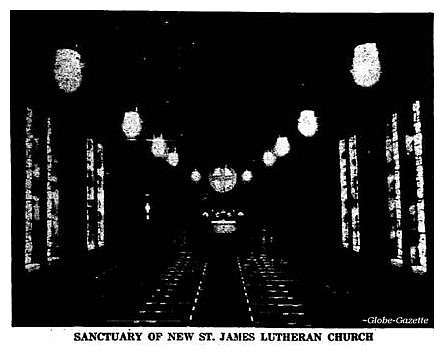


Cerro Gordo County Iowa
Part of the IaGenWeb Project
|
An Evangelical Lutheran Church with Northeastern Iowa Synod 1148 4th Street SE, Mason City Mason Township, Cerro Gordo County, Iowa
Globe-Gazette, Mason City, Cerro Gordo County, Iowa
The congregation was incorporated that year as the St. James Lutheran Church and a building committee appointed, made up of H. C. Reife, C. W. Paulus, William Henkel and George Rehm. A church was built at 502 Sixth S. E., at a cost of $3,000, which served until the new church on Maple Drive was completed early in 1953. Meanwhile the St. James Lutheran Church continued its growth. The congregation, organized in the 90's, was served from 1892 to 1912 by the Rev. John F. Larch, then by the Rev. A. F. Karsten until 1914. The Rev. Oswald E. G. Mall set a record for ministerial service in Mason City as pastor of St. James from 1914 to 1943. St. James Lutheran congregation was planning a new church on the site of its old church structure on 6th S. E., when the Rev. E[ric]. A. Biedermann was installed as pastor in September, 1948. At the suggestion of the new pastor, the congregation procurred a more spacious plot for the church at Maple Drive and 4th S. E., where a new brick church was erected at a cost of $275,000. The church is a modern treatment of early American designed by Hansen and Waggoner. The completed plans call for four units plus a parsonage. Three of these units, the church proper, the administraiton unit and the fellowship unit have been completed. NOTE: Upon retirement in 1965, Rev. Beidermann and his wife, Mary (Herren), retired to Fort Collins, Colorado. Rev. Biedermann died in April of 1966. Mary died at the age of 102 years on February 24, 2002, Fort Collins, Colorado. SOURCE: Mary (Herren) Biedermann obituary



The church is a combination of the forceful, smooth lines of modernity and the traditions of Christianity, developed over the centuries. Dominating the exterior and lending unity to the structure is the 107 foot high tower which is crowned by the symbol of Christianity - a cross. The completed plans call for four units plus a parsonage. Completed thus far is the church proper, the administrative offices and part of the educational unit. An addition to the plant, for which the foundation has already been laid, will complete the educational unit and provide the fellowship hall. Entrance to the church building is through a spacious tower entrance and parthex. The nave has side walls 28 1/2 feet tall, pierced with six pairs of lancet windows filled with leaded stain glass in modernistic pattern. Walls of the nave are painted a Caribbean blue and the walls of the chancel are done in a lighter shade of the same color. Pews and chancel furniture have a light finish that blends harmoniously with the surroundings. Above the altar is an exquisite rose window through which filter light and color in surpassing beauty. The baptismal font is placed at the foot of the chancel steps. Simple wood beams and trusses support the semi-flat roof. A structural acoustical material is used between wood trusses and beams serving a dual purpose of support and sound treatment. To the left of the chancel are the organ and organ console, to the right the organ pipes, sacristy and working sacristy. At the rear of the nave and above the low roof of the narthex is a stained glass window area consisting of 15 symbolic plaques depicting the life of Christ. A spacious parlor with fireplace and kitchen are located off the narthex directly behind the nave.



The first church, called St. Jacobs Church, was built at 502 Sixth St. S.E., a frame building that now is an apartment house. The name of the church was changed to St. James in 1938. William F. HENKEL, founder of HENKEL Construction Co., was a charter member of the congregation. His son, Carl, oversaw construction of the new brick church at 1148 Fourth St. S.E. in 1953. Otto PETERS, a German immigrant and cabinetmaker, carved the filigreed decorative work in the church sanctuary. Services were conducted in German at first, later in English and German. During World War I, pastors were admonished by city leaders to discontinue the German-language services. But as late as the 1930s, the churches continued to hold them, Mason City historian Art FISCHBECK said.
Longtime St. James member Maxine (ROHDE) ROSE said the German services ended at the beginning of World War II. Her father, Max, attended those services, but she and her siblings did not understand German, she said. Max ROHDE, who was born in America in 1888, was confirmed at the original St. Jacobs Church when all services were in German, ROHDE said. In those days, children attended confirmation all day, five days a week, for several weeks. They were excused from public school to attend, ROSE said. ROSE'S grandfather, Herman ROHDE, came to the United States in the 1880s. He was one of many German immigrants who worked at the brick yards, she said. Others worked at the cement plants, Jacob E. DECKER and Sons meatpacking plant, in construction and at various other locations, including the Clear Lake Bakery.
SOURCE:
BUEHNER, Kristin. "Prosit! Germans cheer their culture's traditions, influence throughout North Iowa."
Globe Gazette Mason City IA. 24 May 2003.
|
Return to Cerro Gordo Church Index Page
Return to Cerro Gordo Home Page